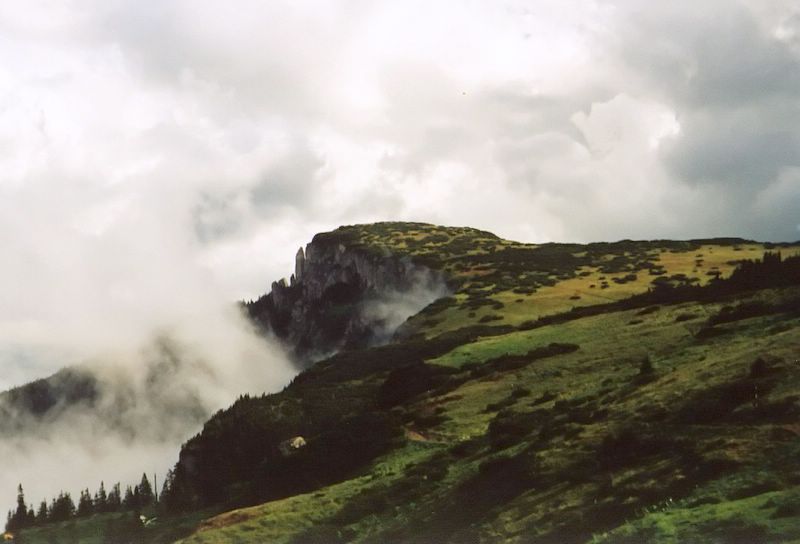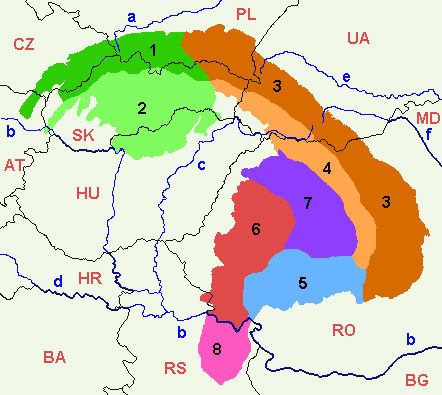|
Bistrița Mountains
The Bistrița Mountains ( ro, Munții Bistriței; hu, Besztercei-havasok) are mountain ranges in northern central Romania. Geologically these ranges are considered part of the Inner Eastern Carpathians group of the Eastern Carpathians. Within Romania, however, it is traditional to divide the Eastern Carpathians in Romanian territory into three geographical groups (north, center, south), instead in Outer and Inner Eastern Carpathians. The Romanian categorization is indicated below. The Bistrița mountain range consist of the following mountains. * Bistrița Mountains (''Munții Bistriței'') per se, comprising ** Pietrosul Massif (''Masivul Pietrosul''; literally: ''Rocky Massif'') ** Budacul Massif (''Masivul Budacul'') ** Ceahlău Massif (''Masivul Ceahlău'') :with the latter sometimes considered a distinct range. In Romania these are considered part of the central Carpathians of Moldavia and Transylvania (''Munții Carpați Moldo-Transilvani''), or "MMT" * Mestecăniș ... [...More Info...] [...Related Items...] OR: [Wikipedia] [Google] [Baidu] |
Maramureș
Maramureș or Marmaroshchyna ( ro, Maramureș ; uk, Мармарощина, Marmaroshchyna; hu, Máramaros) is a geographical, historical and cultural region in northern Romania and western Ukraine. It is situated in the northeastern Carpathian Mountains, Carpathians, along parts of the upper Tisza River drainage basin; it covers the Maramureș Depression and the surrounding Carpathian mountains. Alternatively, the term ''Maramureș'' is also used for the Maramureș County of Romania, which contains the southern section of the historical region. Name in other languages Alternative names for Maramureș include uk, Мармарощина (''Marmaroshchyna''), rue, Мараморош (''Maramoroš''), russian: Мармарош (''Marmarosh''), hu, Máramaros, german: Maramuresch or Marmarosch and la, Marmatia. Geography Maramureș is a valley enclosed by mountains Oaș, Gutâi, Țibleș and Rodnei (northern section of the Inner Eastern Carpathians) to the west and south ... [...More Info...] [...Related Items...] OR: [Wikipedia] [Google] [Baidu] |
Romanian Carpathians
The Romanian Carpathians ( ro, Carpații românești) are a section of the Carpathian Mountains, within the borders of modern Romania. The Carpathians are a "subsystem" of the Alps-Himalaya System and are further divided into "provinces" and "subprovinces". This is an overview of the geological subdivisions of the Romanian section of the Carpathian Mountains. The broadest divisions are shown in the map on the right. The last level of the division, i.e. the actual mountain ranges and basins, is usually called "units". The lowest-level detail for those units is maintained on separate pages. Naming conventions Traditional Romanian naming conventions differ from this list. In Romania, it is usual to divide the Eastern Carpathians in Romanian territory into three geographical groups (North, Centre, South), instead in Outer and Inner Eastern Carpathians. The Transylvanian Plateau is encircled by, and geologically a part of, the Carpathians, but it is not a mountainous region and ... [...More Info...] [...Related Items...] OR: [Wikipedia] [Google] [Baidu] |
Hășmaș Mountains
The Hășmaș Mountains ( Romanian: ''Munții Hășmaș''; Hungarian: ''Hagymás-hegység'') are limestone and sandstone massifs located in Romania, in the Inner Eastern Carpathians group of the Eastern Carpathian Mountains. They belong to the Bistrița Mountains range, and are bordered by the Giurgeu Mountains to the north, the Tarcău Mountains to the east, the Ciuc Mountains to the south, and the Harghita Mountains The Harghita Mountains (in Hungarian Hargita, in Romanian ''Munții Harghita'') is a volcanic mountain range of the Căliman-Harghita Mountains in Harghita County of Romania, part of the Inner Eastern Carpathians. The range is about long an ... to the west. The Hășmaș Mountains include many cliffs and gorges, such as the Bicaz Gorge and the Panaghia Cliff. The highest peak is , at . The mountains contain the Cheile Bicazului-Hășmaș natural reserve. There is a lake known as the Lacul Roșu ("Red Lake"), named after the red clay that lay the ... [...More Info...] [...Related Items...] OR: [Wikipedia] [Google] [Baidu] |
Dorna Depression
Dorna may refer to: Places Austria * Dorna, Austria, a village in the town of Irnfritz-Messern, Horn District in Lower Austria Germany * Dorna (Kemberg), a village, part of the town Kemberg in Wittenberg district in Saxony-Anhalt Romania * Dorna, a village in Așchileu Commune, Cluj County * Dorna-Arini, Suceava County * Dorna Candrenilor, Suceava County * Vatra Dornei, Suceava County * Dorna (river), tributary of the Bistrița in Suceava County Other * Dorna (boat), a design of fishing boat in Galicia in northwestern Spain * Dorna (fire control system), a naval fire control system by Navantia * Dorna (water), a Romanian mineral water bought in 2002 by The Coca-Cola Company * Dorna Sports, the commercial rights holders for MotoGP * Hava Faza Dorna, an Iranian aircraft manufacturer * HESA Dorna, a jet-powered Iranian training aircraft See also * Dornești Dornești (german: Kriegsdorf, hu, Hadikfalva) is a commune located in Suceava County, Romania. It is composed of ... [...More Info...] [...Related Items...] OR: [Wikipedia] [Google] [Baidu] |
Bukovina
Bukovinagerman: Bukowina or ; hu, Bukovina; pl, Bukowina; ro, Bucovina; uk, Буковина, ; see also other languages. is a historical region, variously described as part of either Central or Eastern Europe (or both).Klaus Peter BergerThe Creeping Codification of the New Lex Mercatoria Kluwer Law International, 2010, p. 132 The region is located on the northern slopes of the central Eastern Carpathians and the adjoining plains, today divided between Romania and Ukraine. Settled initially and primarily by Romanians and subsequently by Ruthenians (Ukrainians) during the 4th century, it became part of the Kievan Rus' in the 10th century and then the Principality of Moldavia during the 14th century. The region has been sparsely populated since the Paleolithic, with several now extinct peoples inhabiting it. Consequently, the culture of the Kievan Rus' spread in the region, with the Bukovinian Church administered from Kyiv until 1302, when it passed to Halych metropoly. The ... [...More Info...] [...Related Items...] OR: [Wikipedia] [Google] [Baidu] |
Obcina Mestecăniș Mountains
The Obcina Mestecăniș Ridge is a range of mountains in Romania. Geologically they belong to the Moldavian-Muntenian Carpathians group of the Outer Eastern Carpathians subprovince. Within Romania, however, it is traditional to divide the Eastern Carpathians (''Carpații Orientali'') into three geographical groups (north, center and south) instead. The Romanian categorization includes Mestecăniș Ridge within the northern Carpathians of Maramureș and Bukovina (''Grupa Nordică'', ''Munții Carpați ai Maramureșului și Bucovinei''). The Suceava River emerges from these mountains. The highest peak is , at . The mountain range is part of the Ridges of Bukovina (''Obcinele Bucovinei''). See also * Divisions of the Carpathians Divisions of the Carpathians are a categorization of the Carpathian mountains system. Below is a detailed overview of the major subdivisions and ranges of the Carpathian Mountains. The Carpathians are a "subsystem" of a bigger Alps-Himalaya Sy ... ... [...More Info...] [...Related Items...] OR: [Wikipedia] [Google] [Baidu] |
Romania
Romania ( ; ro, România ) is a country located at the crossroads of Central Europe, Central, Eastern Europe, Eastern, and Southeast Europe, Southeastern Europe. It borders Bulgaria to the south, Ukraine to the north, Hungary to the west, Serbia to the southwest, Moldova to the east, and the Black Sea to the southeast. It has a predominantly Temperate climate, temperate-continental climate, and an area of , with a population of around 19 million. Romania is the List of European countries by area, twelfth-largest country in Europe and the List of European Union member states by population, sixth-most populous member state of the European Union. Its capital and largest city is Bucharest, followed by Iași, Cluj-Napoca, Timișoara, Constanța, Craiova, Brașov, and Galați. The Danube, Europe's second-longest river, rises in Germany's Black Forest and flows in a southeasterly direction for , before emptying into Romania's Danube Delta. The Carpathian Mountains, which cross Roma ... [...More Info...] [...Related Items...] OR: [Wikipedia] [Google] [Baidu] |
Transylvania
Transylvania ( ro, Ardeal or ; hu, Erdély; german: Siebenbürgen) is a historical and cultural region in Central Europe, encompassing central Romania. To the east and south its natural border is the Carpathian Mountains, and to the west the Apuseni Mountains. Broader definitions of Transylvania also include the western and northwestern Romanian regions of Crișana and Maramureș, and occasionally Banat. Transylvania is known for the scenery of its Carpathian landscape and its rich history. It also contains Romania's second-largest city, Cluj-Napoca, and other iconic cities and towns such as Brașov, Sibiu, Târgu Mureș, Alba Iulia and Sighișoara. It is also the home of some of Romania's List of World Heritage Sites in Romania, UNESCO World Heritage Sites such as the villages with fortified churches in Transylvania, Villages with fortified churches, the Historic Centre of Sighișoara, the Dacian Fortresses of the Orăștie Mountains and the Rosia Montana Mining Cultural Landsc ... [...More Info...] [...Related Items...] OR: [Wikipedia] [Google] [Baidu] |
Moldavia
Moldavia ( ro, Moldova, or , literally "The Country of Moldavia"; in Romanian Cyrillic: or ; chu, Землѧ Молдавскаѧ; el, Ἡγεμονία τῆς Μολδαβίας) is a historical region and former principality in Central and Eastern Europe, corresponding to the territory between the Eastern Carpathians and the Dniester River. An initially independent and later autonomous state, it existed from the 14th century to 1859, when it united with Wallachia () as the basis of the modern Romanian state; at various times, Moldavia included the regions of Bessarabia (with the Budjak), all of Bukovina and Hertsa. The region of Pokuttya was also part of it for a period of time. The western half of Moldavia is now part of Romania, the eastern side belongs to the Republic of Moldova, and the northern and southeastern parts are territories of Ukraine. Name and etymology The original and short-lived reference to the region was ''Bogdania'', after Bogdan I, the fo ... [...More Info...] [...Related Items...] OR: [Wikipedia] [Google] [Baidu] |




.jpg)
